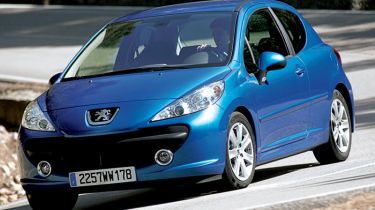Peugeot 207 (2006) review
The replacement for the Peugeot 206 is set to hit the road in June. We get behind the wheel of the all-new 207

Rather than start from scratch, Peugeot has built on the strengths of the 206 and ironed out its weaknesses. So buyers still get the attractive lines that made the outgoing model such a hit, yet enjoy a much more capable all-rounder. And while in petrol guise the 207 is short of the mark - for now at least - the diesel versions are very tempting propositions.
Pretty, individual and, above all else, cheap to run, Peugeot's 206 is one of the best-selling cars of the decade. But time has well and truly caught up with the supermini.
As our Driver Power 2006 report shows, the replacement 207 can't come soon enough. It's due on sale in the UK in June, and we've got behind the wheel of one of the first models out of the factory.
In showroom-ready trim, the 207's similarity to the 206 is clear to see. Yet amazingly, the new machine is virtually identical in size to the old 306 - a hatchback that belonged to the class above. It's no surprise, then, that the latest Lion is much more spacious than the 206. One of the biggest failings of the outgoing model was its appalling driving position; not so in the 207. Designers have answered the critics, and there's plenty of adjustment for both the seat and steering wheel.
Used - available now

2019 Land Rover
Range Rover Evoque
56,252 milesAutomaticPetrol2.0L
Cash £16,000
2019 Land Rover
Range Rover Evoque
68,368 milesManualDiesel2.0L
Cash £9,500
2015 Nissan
Qashqai
86,291 milesManualPetrol1.2L
Cash £5,500
2014 BMW
5 Series
39,874 milesAutomaticDiesel2.0L
Cash £9,998The dashboard is well laid out and appears expertly put together, too. It's just a pity the budget couldn't stretch to using the dashtop's high-class plastics around the handbrake.
You'll get few complaints from rear occupants, the three-door 207 giving easy access to the back. There's plenty of legroom, too, although the tapered window line cuts into shoulder space.
So Peugeot has made plenty of progress inside - but does the 207 have its predecessor's lively character on the road? From the first turn of the wheel, it's clear that this car has grown up. Thanks to the wider track, the 207 is always stable. Peugeot wanted the model to feel sporty even in basic trim, and the result is a hatchback with fairly firm settings. But it's never uncomfortable and there is sufficient feedback.
Well weighted steering adds to the sense of involvement. While the rack is electrically assisted, the nose reacts fast to subtle inputs from the wheel.
As the road becomes more challenging, the newcomer proves just as capable. And although it's based on the same platform as Peugeot's 1007 city car, as well as the Citroen C2 and C3, the 207 feels very composed.
While the 206's tendency to slide through corners has been replaced by greater stability, you can still have fun. However, the new supermini has inherited its predecessor's engine range. This is good news for diesel buyers, because the 1.6-litre powerplant co-developed with Ford offers torquey performance. But the 1.6 petrol in our car is unrefined and lethargic.
Fortunately, a new 1.6 - which has been designed in conjunction with BMW, and will be offered in a choice of naturally aspirated or turbocharged guises - is due later this year.
Although prices have yet to be announced, Peugeot bosses have confirmed that the 207 will be close to the Fiat Grande Punto and Renault's new Clio. That means entry-level models will cost around £9,000, with the 1.6-litre Sport at about £11,000.
Go for a diesel 207 and you won't be disappointed, but the current 1.6-litre unit is the weak link in the flagship petrol car. So while the latest Peugeot is impressive, until the new engines arrive, class rivals have the upper hand.







